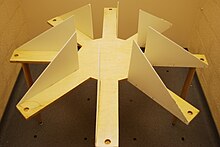Radial arm maze: Difference between revisions
m fix headline (WikiProject Check Wikipedia check #57 |
|||
| Line 25: | Line 25: | ||
[[Category:Mazes]] |
[[Category:Mazes]] |
||
[[Category:Behavioral neuroscience]] |
[[Category:Behavioral neuroscience]] |
||
this is not true |
|||
Revision as of 18:27, 2 October 2009

The radial arm maze was designed by Olton and Samuelson in 1976 to measure spatial learning and memory in rats[1]. The original apparatus consists of eight equidistantly-spaced arms, each about 4 feet long, and all radiating from a small circular central platform (later versions have used as few as three[2] and as many as 48 arms[3]). At the end of each arm there is a food site, the contents of which are not visible from the central platform.
The design ensures that, after checking for food at the end of each arm, the rat is always forced to return to the central platform before making another choice. As a result, the rat always has eight possible options. Elaborate controls are used to ensure that the rats are not simply using their sense of smell, either to sense unclaimed food objects or to sense their own tracks.
Olton and Samuelson found that rats have excellent memories for visited and or unvisited arms; they made, on average, about 7.0 novel entries in their first 8 choices, and thus were 88% correct.[1] Chance performance with eight arms would be 5.3 novel entries in the first 8 choices (66% correct). Olton and Samuelson also found when they switched some already-visited arms into as yet unvisited locations partway through a trial, the rats tended to visit as-yet unvisited locations even when doing so meant running down arms that had already been traversed, and tended to avoid arms that had not yet been traversed but were now in previously visited locations.[1] It seems that in remembering locations on the radial arm maze, rats do not rely on local intra-maze cues, but rather on extra-maze cues.
The maze has since been used by researchers interested in studying the spatial learning and spatial memory of animals. For example, Olton, Collison, and Werz found that performance declined only slightly to 82% novel entries in the first 17 entries on a 17-arm maze.[4] Roberts found no decline in the percentage of correct choices as the number of arms on a radial maze were increased from 8 to 16 and then to 24.[5] Cole and Chappell-Stephenson, using a radial maze with food locations ranging from 8 to 48, estimated the limit of spatial memory in rats to be between 24 and 32 locations.[3]
In mice, large differences in learning ability exist among different inbred strains. These differences appear to be correlated with the size of a part of the hippocampal mossy fiber projection.[6]
References
- ^ a b c Olton, D.S., & Samuelson, R.J. (1976). Remembrance of places passed: Spatial memory in rats. Journal of Experimental Psychology: Animal Behavior Processes, 2, 97-116.
- ^ Lenck-Santini PP, Save E, Poucet B. (2001). Place-cell firing does not depend on the direction of turn in a Y-maze alternation task. Eur J Neurosci. 13(5):1055-8.
- ^ a b Cole, M.R., & Chappell-Stephenson. (2003). Exploring the limits of spatial memory using very large mazes. Learning & Behavior, 31, 349-368.
- ^ Olton, D.S, Collison, C., & Werz, M.A. (1977). Spatial memory and radial arm maze performance of rats. Learning & Motivation, 8, 289-314.
- ^ Roberts, W.A. (1979). Spatial memory in the rat on a hierarchical maze. Learning & Motivation, 10, 117-140.
- ^ W. E. Crusio & H. Schwegler (2005). "Learning spatial orientation tasks in the radial-maze and structural variation in the hippocampus in inbred mice". Behavioral and Brain Functions. 1: 3. doi:10.1186/1744-9081-1-3.
{{cite journal}}: CS1 maint: unflagged free DOI (link)
this is not true
